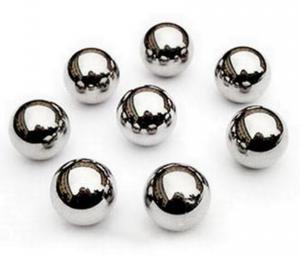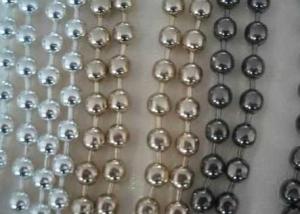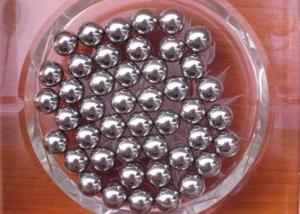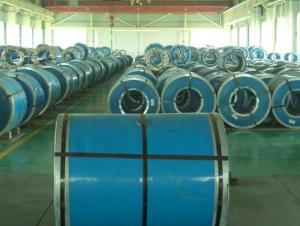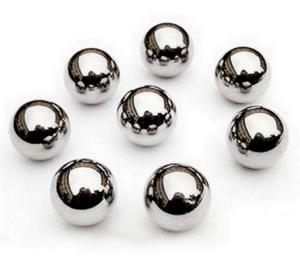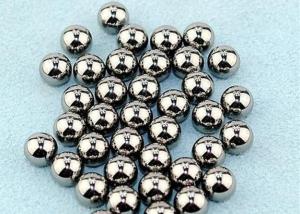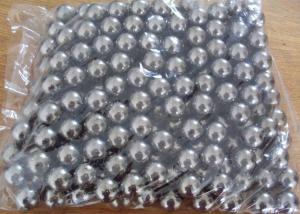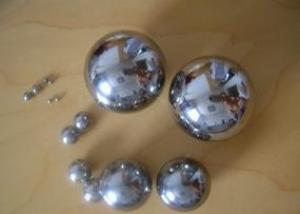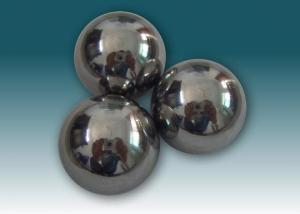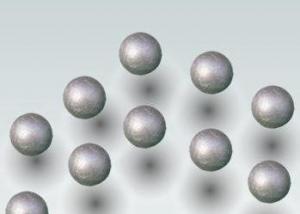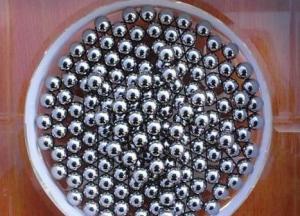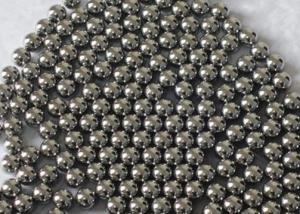304 Stainless Steel Balls
- Loading Port:
- Tianjin Port
- Payment Terms:
- TT or LC
- Min Order Qty:
- 1 Ton pc
- Supply Capability:
- 500 Tons Per Month pc/month
OKorder Service Pledge
OKorder Financial Service
You Might Also Like
Main Products Of 304 Stainless Steel Ball:
1. Material: AISI304, 316L, 420C, 430, 440C
2. Steel ball, with material AISI 1008-1086.
3. Chrome steel ball,with material: AISI52100
4. Flying saucer steel ball
5. Precision casting, including auto parts, machine parts, hardware handles, etc.
Character Of 304 Stainless Steel Ball:
1.The Grade of our products is from G10 to G1000
2.The dimension is from 0.5 mm to 25.4 mm.
3.The products from us are widely used in several industries, such as hardware, sliders, ball bearing lead screw, wheels, toys, bicycles, bearings, trust bearings pulleys, chemical industries, etc.
Detail Specification Of 304 Stainless Steel Ball:
Item | SS304,316L,420C,440C Stainless steel ball |
Category | Stainless Steel Ball |
Material | AISI 420 430 440 SS304 316L |
Size | 0.5mm--25.4mm, 1/4",3/16",5/32",1/8",7/32",5/16",7/8",1" |
Grade | G100-G3000 |
Hardness ( HRC) | HRC58-65 |
Application | Bicycle, bearing, pulley, slide, handcraft, shelf, luggage, hardware, grinding media |
Standard | GB/T-308-2002, GB/T1148-93 |
Matched Standard | DIN, JIS, ASME |
Certification | ISO |
Packing | Oily packing in pouch packing,plastic/tin box packing 1, 25kg/carton with steel pallet packing 2,25kg/carton without steel pallet packing 3,10kg/box then in wooden case packing 4,250kg/ steel drum packing or according to customers' requirement |
Place of original | Shandong province, China |
Delivery | Within 30 days or confirmed while placing order |
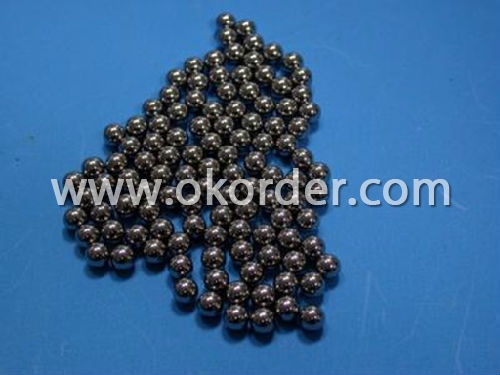
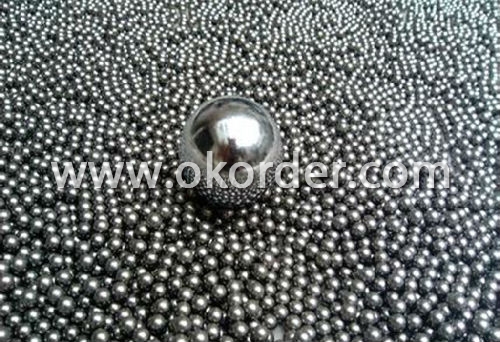

- Q:What are the properties of stainless steel balls?
- Stainless steel balls are highly sought after in various applications due to several key properties they possess. Firstly, their excellent corrosion resistance ensures that they remain resistant to rust and oxidation. This is primarily because the steel contains chromium, which creates a protective oxide layer on the surface, preventing any further corrosion. Additionally, stainless steel balls exhibit high hardness and strength, enabling them to withstand demanding conditions and applications that require durability and resistance to wear and tear. This characteristic allows them to maintain their shape and integrity even under heavy loads or in high-temperature environments. Another significant property of stainless steel balls is their magnetic capability. Depending on the specific grade of stainless steel used, these balls can either be magnetic or non-magnetic. This versatility makes them suitable for various industries, including automotive, aerospace, and medical, where magnetic properties may be required or avoided. Moreover, stainless steel balls are renowned for their exceptional dimensional accuracy and precision. They can be manufactured to extremely tight tolerances, ensuring consistent and reliable performance. This is particularly crucial in applications such as ball bearings, valves, and measurement instruments, where precise dimensions are vital for optimal functionality. Lastly, stainless steel balls are known for their hygienic properties, making them ideal for use in food processing and medical equipment. They are highly resistant to bacterial growth and can withstand frequent cleaning and sterilization without compromising their integrity. In conclusion, the versatility and reliability of stainless steel balls, with their corrosion resistance, hardness, magnetic capability, dimensional accuracy, and hygienic properties, make them an excellent choice for a wide range of applications in various industries.
- Q:Can stainless steel balls be used in solar panel or renewable energy systems?
- Certainly! Stainless steel balls have a wide range of applications in solar panel and renewable energy systems. The reason behind this is that stainless steel possesses exceptional qualities such as durability, resistance to corrosion, and a high melting point, which make it a perfect choice for numerous purposes in the renewable energy field. In solar panel systems, stainless steel balls can be utilized in various components like bearings, connectors, and mounting systems. These balls play a crucial role in providing structural support, ensuring smooth movement, and guaranteeing the system's longevity. Additionally, stainless steel balls are commonly employed in wind turbines, hydroelectric systems, and other renewable energy technologies due to their strength and ability to withstand environmental factors.
- Q:How do stainless steel balls perform in cryogenic storage tanks?
- Stainless steel balls perform exceptionally well in cryogenic storage tanks. Cryogenic storage tanks are designed to store materials at extremely low temperatures, typically below -150°C (-238°F). Stainless steel has excellent mechanical properties and is highly resistant to low temperatures, making it an ideal material for cryogenic applications. Stainless steel balls in cryogenic storage tanks offer several advantages. Firstly, they have high strength and toughness, enabling them to withstand the extreme conditions within the tank. This is crucial as cryogenic temperatures can cause materials to become brittle and prone to failure. Stainless steel's ability to maintain its mechanical properties at low temperatures ensures the integrity and durability of the balls. Secondly, stainless steel has excellent corrosion resistance, even at cryogenic temperatures. Cryogenic storage tanks often contain liquefied gases or chemicals that can be highly corrosive. Stainless steel's resistance to corrosion ensures that the balls remain unaffected by the harsh environment, preventing any degradation or contamination of the stored materials. Furthermore, stainless steel balls have low thermal conductivity, which is beneficial in cryogenic storage tanks. This property helps to minimize heat transfer between the stored materials and the tank walls, reducing the risk of temperature fluctuations or loss of cryogenic properties. The low thermal conductivity also contributes to energy efficiency by conserving the cold temperatures within the tank. In summary, stainless steel balls perform exceptionally well in cryogenic storage tanks due to their high strength, excellent corrosion resistance, and low thermal conductivity. These properties ensure the balls can withstand the extreme temperatures and harsh environments, while effectively storing and preserving materials in cryogenic conditions.
- Q:Are stainless steel balls used in any automotive engine components?
- Yes, stainless steel balls are used in various automotive engine components. One of the primary applications is in the valve train system. The valve train is responsible for controlling the intake of air and fuel into the engine and the exhaust of combustion gases. Stainless steel balls are commonly used in the valve seats, which are the surfaces that the valves rest on when closed. These balls provide a durable and smooth surface for the valves to seal against, ensuring proper compression and preventing leaks. Another application of stainless steel balls in automotive engines is in the fuel injection system. Fuel injectors are responsible for delivering fuel into the combustion chamber at precise intervals and in the correct amount. Stainless steel balls are used in the injector nozzles, which control the flow of fuel into the engine. The smooth surface of these balls helps to maintain the accuracy and efficiency of the fuel injection process. Furthermore, stainless steel balls can also be found in various bearings used in automotive engines. Bearings are crucial components that reduce friction between moving parts, such as crankshafts, camshafts, and connecting rods. Stainless steel balls are used in these bearings to provide smooth rotation and support heavy loads, ensuring the engine operates smoothly and efficiently. In summary, stainless steel balls are indeed used in several automotive engine components, including valve seats, fuel injector nozzles, and bearings. These balls contribute to the proper functioning of the engine by providing durability, smooth operation, and accurate fuel delivery.
- Q:What are the different packaging materials used for stainless steel balls?
- The packaging materials used for stainless steel balls differ depending on their intended use and the industry's requirements. Some commonly used packaging materials are as follows: 1. Plastic bags: Stainless steel balls are often packaged individually or in bulk quantities using plastic bags. These bags provide basic protection against dust, moisture, and scratches. 2. Cardboard boxes: Occasionally, stainless steel balls are packed in cardboard boxes, especially when they need to be transported or shipped in larger quantities. These boxes offer additional protection and can be easily stacked and stored. 3. Foam inserts: To prevent damage during transportation or storage, stainless steel balls may be packed with foam inserts. These inserts act as cushions and absorb any impact, reducing the risk of scratches or deformation. 4. Vacuum-sealed bags: In industries like medical or food processing, stainless steel balls may be packaged in vacuum-sealed bags. This method ensures a sterile and contaminant-free environment, maintaining the quality and integrity of the balls. 5. Tubes or cylinders: Large-sized or high-precision stainless steel balls may be packaged in cylindrical tubes. These tubes provide excellent protection against external forces and maintain the balls' dimensional accuracy. 6. Custom packaging: Depending on specific customer requirements, stainless steel balls can be packaged using custom materials like wooden crates, metal containers, or specialized cases. This guarantees maximum protection and facilitates efficient handling and storage. When selecting the appropriate packaging material for stainless steel balls, it is crucial to consider their intended use, transportation, and storage conditions. The goal is to safeguard the balls from environmental factors, minimize the risk of damage or contamination, and ensure they reach end-users in optimal condition.
- Q:How do stainless steel balls perform in chemical reactors?
- Stainless steel balls are commonly used in chemical reactors due to their excellent performance and durability. They are highly resistant to corrosion and can withstand harsh chemical environments, making them suitable for various applications. In chemical reactors, stainless steel balls play a crucial role in promoting efficient mixing and dispersion of reactants. Their smooth surface and uniform shape ensure minimal friction and allow for consistent flow of substances within the reactor vessel. This enhances the reaction kinetics and increases the overall efficiency of the process. Moreover, stainless steel balls can resist high temperatures and pressures, making them suitable for use in reactors operating under extreme conditions. They maintain their structural integrity and do not deform or break down, ensuring a long lifespan and reducing the need for frequent replacements. Additionally, stainless steel balls have excellent chemical stability, meaning they do not react with most chemicals present in the reactor. This prevents contamination of the reaction mixture and ensures the purity of the final product. Their inert nature also makes them suitable for handling sensitive or reactive substances. Overall, stainless steel balls perform exceptionally well in chemical reactors, offering durability, corrosion resistance, efficient mixing, and compatibility with various chemicals. They are a reliable choice for industries requiring reliable and long-lasting equipment for their chemical processes.
- Q:Are stainless steel balls used in chemical processing equipment?
- Yes, stainless steel balls are commonly used in chemical processing equipment due to their corrosion resistance, durability, and ability to withstand high temperatures and pressure. They are often utilized in valves, pumps, mixers, and other components to ensure efficient and reliable operation in various chemical processes.
- Q:Can stainless steel balls be used in fluid mixing applications?
- Fluid mixing applications can indeed utilize stainless steel balls. Stainless steel is widely used in many industrial settings because of its exceptional resistance to corrosion and durability. When employed in fluid mixing, stainless steel balls effectively agitate and blend fluids, guaranteeing comprehensive homogenization. Their sleek surface and dense composition make them perfect for generating turbulence and promoting fluid flow within a mixing container. Furthermore, stainless steel balls are simple to clean and maintain, rendering them appropriate for hygienic applications. All in all, stainless steel balls are a dependable option for fluid mixing applications because of their strength and ability to work well with various fluids.
- Q:Are stainless steel balls prone to rust?
- No, stainless steel balls are not prone to rust.
- Q:Are stainless steel balls magnetic in all grades?
- No, stainless steel balls are not magnetic in all grades. The magnetic properties of stainless steel balls depend on the specific grade and composition of the steel. Austenitic stainless steels, such as grades 304 and 316, are generally non-magnetic due to their high chromium and nickel content. These grades are often used in applications where non-magnetic properties are desired, such as in food processing or medical equipment. On the other hand, martensitic and ferritic stainless steels, such as grades 410 and 430, can be magnetic because they have lower nickel content and different crystal structures. Therefore, it is important to consider the specific grade of stainless steel when determining its magnetic properties.
1. Manufacturer Overview |
|
|---|---|
| Location | Guangzhou,China |
| Year Established | 2001 |
| Annual Output Value | Above US$0.5 Million |
| Main Markets | Southeast Asia, Europe |
| Company Certifications | ISO 9001:2008; |
2. Manufacturer Certificates |
|
|---|---|
| a) Certification Name | |
| Range | |
| Reference | |
| Validity Period | |
3. Manufacturer Capability |
|
|---|---|
| a)Trade Capacity | |
| Nearest Port | Shanghai |
| Export Percentage | 30% |
| No.of Employees in Trade Department | 10 People |
| Language Spoken: | English;Chinese |
| b)Factory Information | |
| Factory Size: | Above 30,000 square meters |
| No. of Production Lines | Above 7 |
| Contract Manufacturing | OEM Service Offered;Design Service Offered |
| Product Price Range | Average |
Send your message to us
304 Stainless Steel Balls
- Loading Port:
- Tianjin Port
- Payment Terms:
- TT or LC
- Min Order Qty:
- 1 Ton pc
- Supply Capability:
- 500 Tons Per Month pc/month
OKorder Service Pledge
OKorder Financial Service
Similar products
New products
Hot products
Hot Searches
Related keywords
